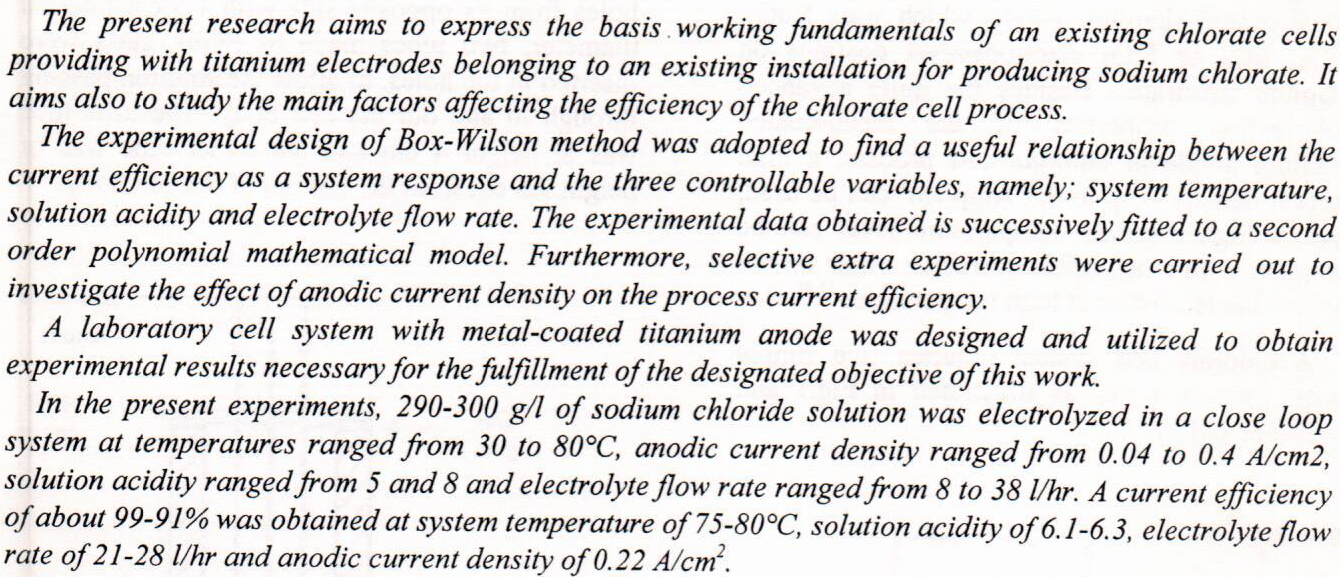
The combined system of electrocoagulation (EC) and electro-oxidation (EO) is one of the most promising methods in dye removal. In this work, a solution of 200 mg/l of Congo red was used to examine the removal of anionic dye using an EC-EO system with three stainless steel electrodes as the auxiliary electrodes and an aluminum electrode as anode for the EC process, Cu-Mn-Ni Nanocomposite as anode for the EO process. This composite oxide was simultaneously synthesized by anodic and cathodic deposition of Cu (NO3)2, MnCl2, and Ni (NO3)2 salts with 0.075 M as concentrations of each salt with a fixed molar ratio (1:1:1) at a constant current density of 25 mA/cm2. The characteristics structure and surface morphology of the depo
... Show MoreObjective: Determination the effectiveness of educational program on female students’ practices toward premenstrual.
Methodology: A quasi-experimental design study was conducted involving (140) student purposely in four secondary schools at Al-sadder city (70) student for study group and (70) for control group. The prevalence of PMS selected through American College of Obstetricians and Gynecologists (ACOG) (2015) criteria to select PMS students before program. The education program were set in four steps, the first step (pre-test) is to assess the practices, before the implementation of the program, the second step is implementing the program, following two steps post-test I and II betwe
... Show MoreStreamlined peristaltic transport patterns, bifurcations of equilibrium points, and effects of an inclined magnetic field and channel are shown in this study. The incompressible fluid has been the subject of the model's investigation. The Reynolds values for evanescence and an infinite wavelength are used to constrain the flow while it is being studied in a slanted channel with a slanted magnetic field. The topologies over their domestic and cosmopolitan bifurcations are investigated for the outcomes, and notion of the dynamical system are employed. The Mathematica software is used to solve the nonlinear autonomous system. The flow is found to have three different flow distributions namely augmented, trapping and backward flow. Outc
... Show More (8)
(8)
 (4)
(4)
This paper compare the accurecy of HF propagation prediction programs for HF circuits links between Iraq and different points world wide during August 2018 when solar cycle 24 (start 2009 end 2020) is at minimun activity and also find out the best communication mode used. The prediction programs like Voice of America Coverage Analysis Program (VOACAP) and ITU Recommendation RS 533 (REC533 ) had been used to generat HF circuit link parameters like Maximum Usable Frequency ( MUF) and Frequency of Transsmision (FOT) .Depending on the predicted parameters (data) , real radio contacts had been done using a radio transceiver from Icom model IC 7100 with 100W RF
... Show More (2)
(2)
 (1)
(1)
 (53)
(53)
 (48)
(48)
 (4)
(4)
 (3)
(3)
In this paper, some series of new complexes of Mn(II), Co(II), Ni (II) Cu(II) and Hg(II) are prepared from the Schiff bases (L1,L2). (L1) derived from 4-aminoantipyrine and O-phenylene dia mine then (L2) derived from (L1) and 2-benzoyl benzoic acid. Structural features are obtained from their elemental microanalyses, molar conductance, IR, UV–Vis, 1H, 13CNMR spectra and magnetic susceptibility. The magnetic susceptibility and UV–Vis, IR spectral data of the ligand (L1) complexes get square–planar and tetrahedral geometries and the complexes oflig and (L2) get an octahedral geometry. Antimicrobial examinations show good results in the sharing complexes.
 (18)
(18)
 (2)
(2)
 (1)
(1)
 (11)
(11)
 (10)
(10)
